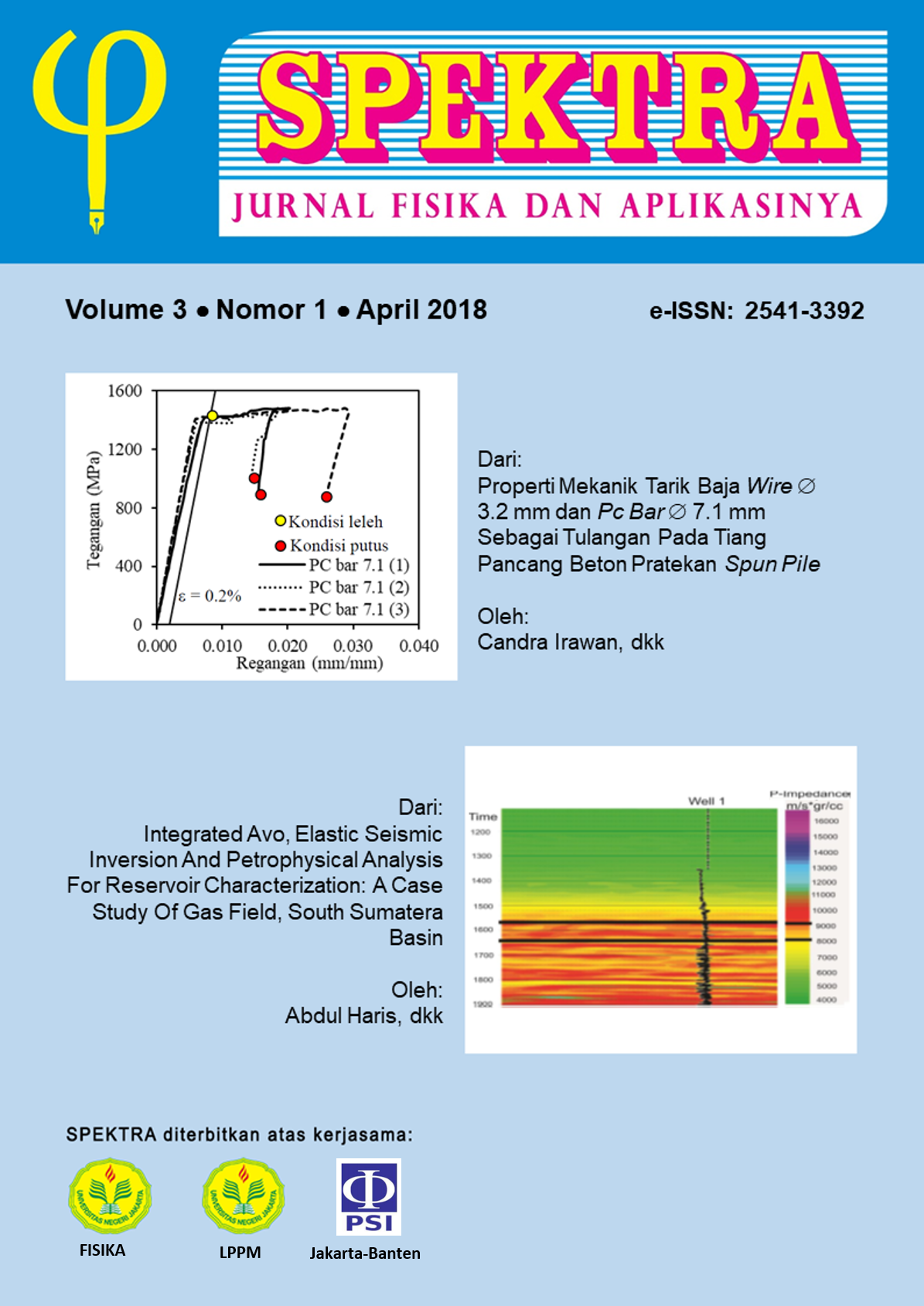MOISTURE ABSORPTION AND FTIR CHARACTERISTIC OF TAPIOCA STARCH BIOCOMPOSITE REINFORCED DRAGON FRUIT ROOT FIBER (HYLOCEREUS POLYRHIZUS)
DOI:
https://doi.org/10.21009/SPEKTRA.031.01Keywords:
biocomposites, tapioca starch, dragon fruit root fiber, FTIR, moisture absorptionAbstract
Abstrak
Biokomposit dari pati tapioka dan serat akar buah naga telah berhasil dibuat. Sebanyak 0, 2, 4, dan 6% serat (dari berat kering pati) digunakan sebagai penguat biokomposit. Fabrikasi biokomposit menggunakan metode solution casting. Pengujian serapan uap air digunakan untuk mengetahui persentase penyerapan uap air. Gugus fungsi dari biokomposit ditentukan dengan karakterisasi FTIR (Fourier Transform Infra-Red). Persentase penyerapan uap air menunjukkan bahwa, film pati tapioka mempunyai serapan uap 21,7%. Hasil ini lebih tinggi dibandingkan dengan film tapioka ditambah serat. Fenomena ini didukung dengan analisis FTIR pada gugus serapan air sekitar wavenumber 1647 cm-1. Pada daerah tersebut terlihat bahwa, film pati tapioka memiliki absorban yang tinggi dibandingkan film pati tapioka ditambah serat.
Kata-kata kunci: biokomposit, pati tapioka, serat akar buah naga, FTIR, serapan uap air.
Abstract
Tapioca starch biocomposites reinforced dragon fruit root fiber was successfully produced. As much 0, 2, 4 and 6% fiber fractions (from dry starch weight basis) were used as reinforcement in biocomposites. The fabrication of biocomposites was solution casting method. Moisture absorption testing was used to know the percentage of moisture absorption. The functional group of biocomposites was determined by FTIR (Fourier Transform Infra-Red) characterization. The moisture absorption percentage of tapioca starch film was 21,7%. This result was higher than fiber-reinforced biocomposites film. This phenomenon was supported by FTIR analysis on functional group (water absorption band) at wavenumber 1647 cm-1. In this wavenumber, tapioca starch film has higher absorbance than fiber-reinforced biocomposites film.
Keywords: biocomposites, tapioca starch, dragon fruit root fiber, FTIR and moisture absorption.
References
[2] K. Kaewtatip, and J. Thongmee, “Studies on the Structure and Properties of Thermoplastic Starch / Luffa Fiber Composites,†Mater. Des., vol. 40, pp. 314–318, 2012.
[3] H. Abral, M.F. Gafar, H. Andriyanto, Ilhamdi, S.M. Sapuan, M.R. Ishak, and Evitayani, “Alkali Treatment of Screw Pine (Pandanus Odoratissimus) Fibers and Its Effect on Unsaturated Polyester Composites,†Polym. Plast. Technol. Eng., vol. 51, no. 1, pp. 12-18, 2012.
[4] H. Abral, and J. Hartono, “Moisture Absorption of Starch Based Biocomposites Reinforced with Water Hyacinth Fibers,†IOP Conf. Ser. Mater. Sci. Eng., vol. 213 (September 2017), 2017.
[5] O. Faruk, A.K. Bledzki, H.P. Fink, and M. Sain, “Biocomposites Reinforced with Natural Fibers : 2000 – 2010,†Prog. Polym. Sci., vol. 37, no. 11, pp. 1552–1596, 2012.
[6] M. Asrofi, H. Abral, Y.K. Putra, S.M. Sapuan, and H.J. Kim, “Effect of Duration of Sonication During Gelatinization on Properties of Tapioca Starch Water Hyacinth Fiber Biocomposite,†Int. J. Biol. Macromol., vol. 108, pp. 167-176, 2018.
[7] H. Abral, G.J. Putra, M. Asrofi, J.W. Park, and H.J. Kim, “Effect of Vibration Duration of High Ultrasound Applied to Bio-Composite While Gelatinized on Its Properties,†Ultrason. Sonochem., vol. 40, pp. 697-702, 2018.
[8] H. Anuar, and A. Zuraida, “Improvement in Mechanical Properties of Reinforced Thermoplastic Elastomer Composite with Kenaf Bast Fibre,†Compos. Part B Eng., vol. 42, no. 3, pp. 462–465, 2011.
[9] S. Lee, and S. Wang, “Biodegradable Polymers / Bamboo Fiber Biocomposite with Bio-Based Coupling Agent,†Compos. Part A Appl. Sci. Manuf., Vol. 37, no. 1, pp. 80–91, 2006.
[10] W. Liu, M. Misra, P. Askeland, L.T. Drzal, and A.K. Mohanty, “‘Green’ Composites From Soy Based Plastic and Pineapple Leaf Fiber: Fabrication and Properties Evaluation,†Polymer, vol. 46, no. 8, pp. 2710–2721, 2005.
[11] J. Prachayawarakorn, S. Chaiwatyothin, S. Mueangta, and A. Hanchana, “Effect of Jute and Kapok Fibers on Properties of Thermoplastic Cassava Starch Composites,†Mater. Des., vol. 47, pp. 309–315, 2013.
[12] F.Z. Arrakhiz, M. Elachaby, R. Bouhfid, S. Vaudreuil, M. Essassi, and A. Qaiss, “Mechanical and Thermal Properties of Polypropylene Reinforced with Alfa Fiber Under Different Chemical Treatment,†Mater. Des., vol. 35, pp. 318–322, 2012.
[13] N.S. Lani, N. Ngadi, A. Johari, and M. Jusoh, “Isolation, Characterization, and Application of Nanocellulose From Oil Palm Empty Fruit Bunch Fiber As Nanocomposites,†J. Nanomater., vol. 2014, pp. 1-9, 2014.
[14] V.P. Cyras, L.B. Manfredi, M.T. Ton-That, and A. Vazquez, “Physical and Mechanical Properties of Thermoplastic Starch / Montmorillonite Nanocomposite Films,†Carbohydr. Polym., vol. 73, no. 1, pp. 55–63, 2008.
Downloads
Published
How to Cite
Issue
Section
License
SPEKTRA: Jurnal Fisika dan Aplikasinya allow the author(s) to hold the copyright without restrictions and allow the author(s) to retain publishing rights without restrictions. SPEKTRA: Jurnal Fisika dan Aplikasinya CC-BY or an equivalent license as the optimal license for the publication, distribution, use, and reuse of scholarly work. In developing strategy and setting priorities, SPEKTRA: Jurnal Fisika dan Aplikasinya recognize that free access is better than priced access, libre access is better than free access, and libre under CC-BY or the equivalent is better than libre under more restrictive open licenses. We should achieve what we can when we can. We should not delay achieving free in order to achieve libre, and we should not stop with free when we can achieve libre.
 SPEKTRA: Jurnal Fisika dan Aplikasinya is licensed under a Creative Commons Attribution 4.0 International License.
SPEKTRA: Jurnal Fisika dan Aplikasinya is licensed under a Creative Commons Attribution 4.0 International License.
You are free to:
Share - copy and redistribute the material in any medium or format
Adapt - remix, transform, and build upon the material for any purpose, even commercially.
The licensor cannot revoke these freedoms as long as you follow the license terms.

 E-ISSN 2541-3392
E-ISSN 2541-3392  Focus & Scope
Focus & Scope  Editorial Team
Editorial Team  Reviewer Team
Reviewer Team  Author Guidelines
Author Guidelines  Article Template
Article Template  Author Fee
Author Fee  Publication Ethics
Publication Ethics  Plagiarism Policy
Plagiarism Policy  Open Access Policy
Open Access Policy  Peer Review Process
Peer Review Process  Retraction & Correction
Retraction & Correction  Licensing & Copyright
Licensing & Copyright  Archiving & Repository
Archiving & Repository  Contact
Contact  Mendeley
Mendeley 

